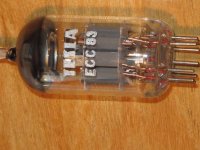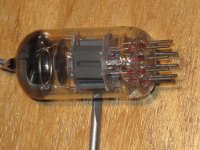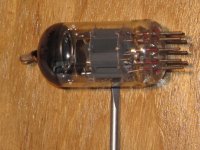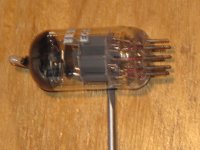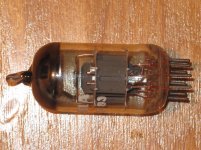It could be that the 6CM5 is a more rugged version of the EL36, so was used in situations where we would have used a PL500/504. The 504 is an upgrade on the 500; similarly the PCL805 frame osc/output was a more rugged version of the PCL85. Usually you only find out what was wrong with a valve design when an improvement is offered.
The 6CM5 is a 6.3V heater version of the PL36, which was used in many European monochrome TV sets. I believe the PL36 was a Philips design, although its US name of 25E5 may indicate the contrary. Near equivalents were produced by other European manufacturers. As screen sizes and deflection angles grew it was superseded by the PL500/504, then PL508 for colour sets.
A rule-of-thumb which I use is to assume that a European valve with an 'early' US name was probably a US design, but one with a 'late' US name was probably a European design. On this basis, for example, I assume that the 6U8/ECF82 was a US design while 6BL8/ECF80 was European. Finding the truth is difficult because in their advertising most makers glossed over questions of development priority; they would announce a new valve and 'forget' to say that it was a copy from someone else (in some cases just 'badge engineering').
6CM5 is EL36...
After PL36 europian BW-TVsets use PL500, and fnaly PL504.
ColourTV start with PL505, than PL509, and finaly PL519. PL508 is small tube for vertical deflection in colour TV.
Oops - memory lapse! You are correct.davorin said:PL508 is small tube for vertical deflection in colour TV.
It could be that the 6CM5 is a more rugged version of the EL36
Yes, that seems to be the case. It does not appear in any US manufacturer's databooks I have. Seems to be an Australian tube, registered in the USA. But did the designers start with an EL36 design, start with a US design, design from scratch, or what? The fact that it has the same grid and screen characteristics doesn't mean a lot. The fact that it is pin compatible with the EL36 and not with common American line output tubes is a perhaps a stronger indicator
However AWV were closely tied to RCA, if they needed to start somewhere, it is more likely they started with an RCA basis.
Hi Like 'jonnyque' who started this thread, I too am a novice at identifying Vacuum Tubes! Having recently purchased a Croft Pre/Power,I have become interested in obtaining tubes that may enhance the sound quality. So, amongst others, I attempted to obtain the original Tesla ECC83! It soon became obvious that this a 'well beaten road' travelled by others before me!! It soon became clear that obtaining these tubes was going to be difficult! However,I found what I know to be , a reputable Dealer who had some! In my initial exchange of emails , the Dealer stated "these are 1970s production from the Roznov factory" !! I subsequently spoke with the Dealer on the telephone who stated these tubes had been obtained as a bulk purchase at that time !! As such, they were not screen printed.(the 'Tesla ECC83' being added by the Dealer)I attach photographs of the tube.I would welcome comments !
Attachments
Bulk purchases valves were usually printed. The only difference between them and retail valves is the lack of a box. Still, at least in this case the dealer is admitting that he faked the printing.
Bulk purchases valves were usually printed. The only difference between them and retail valves is the lack of a box. Still, at least in this case the dealer is admitting that he faked the printing.
Hi DF96
I have no 'issue' with the Dealer .I know him to be an honest person.He was quite open about the source of the tubes so he's not tried to deceive me.
However, when I received the tubes I was not exactly sure what I've got !!
Of all the pictures and information circulating , it appears to me that 'my' tubes possess some of the features of the old Tesla and some of the new JJ version.
Which is why I asked for any feedback from other users!
Now, the most important issue,is how they sound and perform. For that, time will tell.However,clearly I don't wish to 'test' them if they must go back !
The shape of the glass looks more Tesla than JJ.
Yes, I agree, there are other signs that point to Tesla. The shield is coated which indicate Tesla.
Do you have any opinion on the Getter support. Most Tesla ECC83s seem to have a double support whereas mine only one?
I browsed through my left over data books and found in Vade-Mecum 1946 the EF50. This was at the time the tube with the most advanced construction from Philips, but to my knowledge not a frame grid tube. In my Philips pocket book from 1961 I can find ECC88, ECC189, E88CC, E188CC, EF184, E130L, a.s.o, practically all the Philips frame grid types I know of. E83CC and E283CC is not listed, they may be of later date, but to my knowledge they are not frame grid.
I just found Vade-Mecum 1958, no 6DJ8 or 6922 in it (6806 is the highest number) but there are the european types CCa, 88CC , ECC88, E88CC, so frame grid construction probable was first used in europe.
I just found Vade-Mecum 1958, no 6DJ8 or 6922 in it (6806 is the highest number) but there are the european types CCa, 88CC , ECC88, E88CC, so frame grid construction probable was first used in europe.
Unfortunately, only in german but a thorough overview about frame grid audio tubes:
Telefunken ECC803S / Tesla E83CC Spanngitterröhren
Telefunken ECC803S / Tesla E83CC Spanngitterröhren
A Philips pocket book would not necessarily mention a valve not made by Philips (e.g. E83CC), except perhaps to mention a Philips substitute such as some other SQ version of ECC83 which was made by Philips (e.g. M8137). A frame-grid ECC83 is still an ECC83.
Hi,
To the best of my knowledge frame grid tubes were first introduced by Philips. First for the ECC88 series. Later other popular types folled.
E83CC and E283CC are examples. This was tube technology at its peak.
M series were originally Mullard tubes. Philips bougt the company at some point in time as it did with a handful others.
I've always found most Tesla tubes of excellent quality. The E833CC and E88CC being prime examples.
Cheers, 😉
To the best of my knowledge frame grid tubes were first introduced by Philips. First for the ECC88 series. Later other popular types folled.
E83CC and E283CC are examples. This was tube technology at its peak.
M series were originally Mullard tubes. Philips bougt the company at some point in time as it did with a handful others.
I've always found most Tesla tubes of excellent quality. The E833CC and E88CC being prime examples.
Cheers, 😉
Unfortunately, only in german but a thorough overview about frame grid audio tubes:
Telefunken ECC803S / Tesla E83CC Spanngitterröhren
Thnx for the link, according to this, the Siemens C3g from 1952 was the first frame grid tube.
Yes, because the frame grid types where made to be compatible with the ordinary ECC83. To bad that despite frame grid construction we did not get a audio tube with lower Rp and higher gm instead.A frame-grid ECC83 is still an ECC83.
The only advantage we got due to frame grid ECC83 is less microphonic and noise, to bad...
Last edited:
I think we need to ask our friends from the other side of the Great Pond first before giving this statement.Thnx for the link, according to this, the Siemens C3g from 1952 was the first frame grid tube.
Best regards!
I think we need to ask our friends from the other side of the Great Pond first before giving this statement.
Best regards!
I said according to this, did I not?
So what is wrong with my statement?
- Home
- Amplifiers
- Tubes / Valves
- Tesla E83CC - Have done research & still having trouble spotting fakes from real
